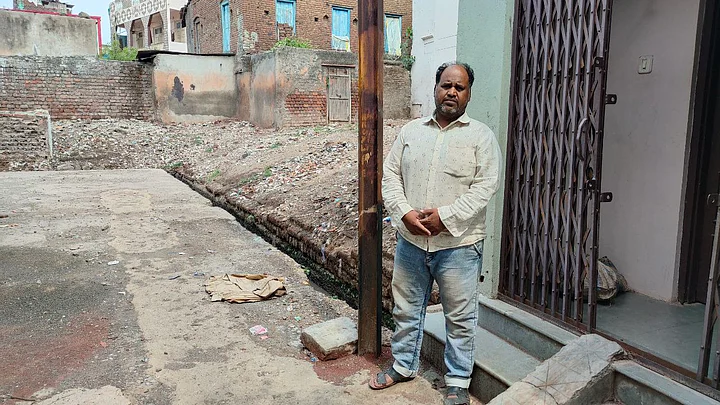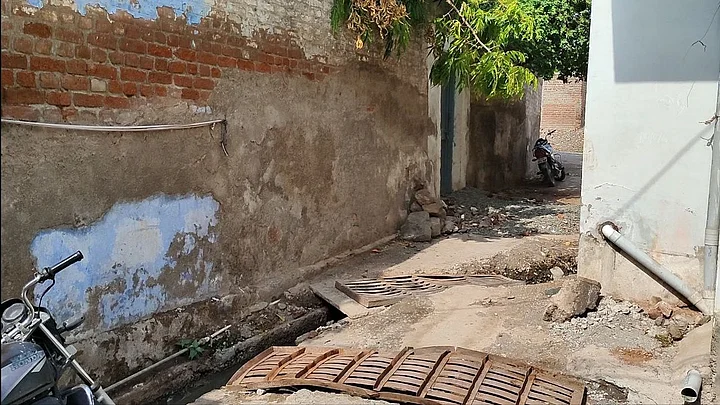Video Editor: Rajbir Singh
Less than 100 metres away from 64-year-old Haji Rasheed's house in Madhya Pradesh's Khargone, a concrete wall stands now – purportedly to separate the Muslim-dominated Khaskhaswadi area from the Hindu-dominated Jameendar Mohalla.
Earlier in June, and roughly two months after violence broke out during a Ram Navami procession in Khargone on 10 April, the wall was erected as "a preventive, temporary solution" by the local administration.
Talking to The Quint, Dharmveer Singh, the newly appointed superintendent of police in Khargone district, said "the decision was made with the consent of local residents."
However, not everyone agrees with this "solution."
Although other routes are still open and are being used by people across communities, Rasheed said this is the first time when "a negative step has been taken to enforce positivity."
“People should be allowed to talk, to stand together, to get back to normal life. We all are trying to reach there, but these physical obstructions will not allow people to forget and forgive and move on from their experience. This will hamper the societal fabric. The walls and barricades must be torn down without hesitation.”Haji Rasheed
'The Wall is a Reminder of the Scars of Violence'
The wall has made life more difficult for 40-year-old Akbar Bagban, a Muslim vegetable seller, whose house has got locked on the other side – in Jameendar Mohalla. But the problem for him is not being cut off from the other houses of his community alone. The wall has made it difficult for him to commute too.
- 01/02
For Akbar, the wall has brought seclusion and left him helpless to move his paralysed father out of the house.
(Photo: Vishnukant Tiwari/The Quint)

- 02/02
Akbar said the open drain is a risk when riding with his paralysed father.
(Photo: Vishnukant Tiwari/The Quint)

Akbar’s house is connected with roads in two directions. However, on the left side, there is an uncovered drain, making it difficult for him to use his vehicle, and the right side has now been made inaccessible due to the wall.
His father is paralysed, and with the commutable road packed off, he has left him in the care of his younger brother.
“The administration said they are doing this to ensure a distance, to ensure clashes do not occur, but what should I tell my paralysed father? I had to leave my father at my brother’s house because I can’t take the risk of transporting him over a drain every day. God forbid if some day my bike slips.”Akbar
Akbar said the wall has ensured that "the scars of violence will be remembered every day."
What Happened in Khargone?
On 10 April, as the country was celebrating Ram Navami, hundreds of people, mostly from the Raghuvanshi community, carried out a peaceful procession during the first half of the day.
Later during the day, a second rally was taken out, in which a large number of people gathered in front of the Talab Chowk area. It was then that members of the two groups clashed, injuring at least 24 people including the then SP Siddharth Choudhary.
The violence, which broke out at Talab Chowk, near Khaskhaswadi, later spread to other parts of the city. Houses and shops were set ablaze, leaving at least one killed. Incidents of stone pelting were reported, following which a curfew was imposed for over three weeks.
Two months on, even as Khargone is trudging towards normalcy, the fears and reservations remain. People still have burnt vehicles outside their homes, the windows smashed by stones remain broken, the roofs carry the rocky evidence of stone pelting and the city, although hustling and bustling at the first glance, stares at people with questioning eyes.
And the bitterness lingers on.
In Hindu-dominated Jameendar Mohalla, 65-year-old Gopal Krishna said, "The wall is a sight of relief," as he sat down on the staircase leading out of his house. Wearing a pale yellow shirt and brown pants, he limped, struggling to balance himself on the platform.
He alleged that his right leg is swollen from the injuries caused by stone pelting.
“We have been troubled a lot, for decades. The young people from Khaskhaswadi would walk down this road and sit in front of our house, playing cards, teasing girls from our locality. This time, when the violence broke out, hundreds came as a mob, and tried to kill our families. We don’t want a repeat. We respect other communities. I have friends among them, but we can’t allow another attack on our families.”Gopal Krishna
Barricading, Bifurcations Will Lead to 'More Bitterness'
Along with Khaskhaswadi, barricading has also been done in some parts of Sanjay Nagar, Bitthal Mandir, and Bhatwadi areas to prohibit inter-community movement.
In the Bitthal Mandir area, an iron barricade stands tall, prohibiting movement between Muslim-dominated Miyanman Mohalla and Baniyawadi Mohalla.
A resident (who wishes to remain anonymous), whose house lies in the Baniyawadi Mohalla, has a rented space in Miyanman Mohalla (both the mohallas are separated by a six-feet-wide cemented road) where she and her husband make mirchi sev, a local street food, and sell it on a cart.
The couple has trouble walking due to old injuries on their feet. They anyhow found it difficult to push their cart on normal days, but with the barricades, the access has become more difficult.
"We know violence happened, but people from our mohalla didn't do it. The Muslims from our locality in fact stood guard during the riots. I came here eight years ago, and we have lived here peacefully since then. The administration has blocked our access to the wider main road, and so every day, we must walk long distances and carry the cart. This should be removed. The road on the other side is less spacious and vehicles can't move."The resident
She added that she had objected to the barricading when they had first come to put it, but nobody paid heed to her, and in fact, they asked her to vacate the house and shift somewhere else.
While this reporter walked through the narrow dingy lanes of Khargone, he met one Sheikh Hakeem, who sat inside a wooden-roofed structure with his grinding machines.
Hakeem, 58, told The Quint that he was carrying on his forefathers' business of wheat-grinding. However, he said his business has reduced to a meagre income of Rs 100-150 per day from Rs 400-500 per day after the violence. The barricading has made it even more difficult for him to earn.
‘Not Permanent, Will Be Pulled Down As Things Get Better’: Police
Police and the administration, however, emphasise that all barricading was done with the consent of local residents.
“We talked with the people of both communities, and thereafter decided to build this wall, and to not remove barricades from certain localities. If this gives the people a sense of security, why not? Moreover, this is not permanent, and it will be pulled down as things move to betterment.”Dharmveer Singh, SP, Khargone
Apart from barricading, the police said they have "increased foot-patrolling and are continuously keeping an eye on the hotspots."
“The senior officers are going on foot every day to the hotspots and are talking with people, discussing their issues, and attempting solutions for the problems,” the SP added.

